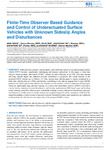Finite-Time Observer Based Guidance and Control of Underactuated Surface Vehicles With Unknown Sideslip Angles and Disturbances
| dc.contributor.author | Wang, Ning | |
| dc.contributor.author | Sun, Z | |
| dc.contributor.author | Yin, J | |
| dc.contributor.author | Su, S-F | |
| dc.contributor.author | sharma, sanjay | |
| dc.date.accessioned | 2018-02-07T13:02:23Z | |
| dc.date.available | 2018-02-07T13:02:23Z | |
| dc.date.issued | 2018 | |
| dc.identifier.issn | 2169-3536 | |
| dc.identifier.issn | 2169-3536 | |
| dc.identifier.uri | http://hdl.handle.net/10026.1/10741 | |
| dc.description.abstract |
Suffering from complex sideslip angles, path following control of an under actuated surface vehicle (USV) becomes significantly challenging and remains unresolved. In this paper, a finite-time observer based guidance and control (FOGC) scheme for path following of an USV with time-varying and large sideslip angles and unknown external disturbances is proposed. The salient features of the proposed FOGC scheme are as follows: 1) time-varying large sideslip angle is exactly estimated by a finite-time sideslip observer, and thereby contributing to the sideslip-tangent line-of-sight guidance law which significantly enhances the robustness of the guidance system to unknown sideslip angles which are significantly large and time-varying; 2) a finite-time disturbance observer (FDO) is devised to exactly observe unknown external disturbances, and thereby implementing FDO-based surge and heading robust tracking controllers, which possess remarkable tracking accuracy and precise disturbance rejection, simultaneously; and 3) by virtue of cascade analysis and Lyapunov approach, global asymptotic stability of the integrated guidance-control system is rigorously ensured. Simulation studies and comparisons are conducted to demonstrate the effectiveness and superiority of the proposed FOGC scheme. | |
| dc.format.extent | 14059-14070 | |
| dc.language.iso | en | |
| dc.publisher | Institute of Electrical and Electronics Engineers (IEEE) | |
| dc.title | Finite-Time Observer Based Guidance and Control of Underactuated Surface Vehicles With Unknown Sideslip Angles and Disturbances | |
| dc.type | journal-article | |
| dc.type | Journal Article | |
| plymouth.volume | 6 | |
| plymouth.publication-status | Published | |
| plymouth.journal | IEEE Access | |
| dc.identifier.doi | 10.1109/access.2018.2797084 | |
| plymouth.organisational-group | /Plymouth | |
| plymouth.organisational-group | /Plymouth/Faculty of Science and Engineering | |
| plymouth.organisational-group | /Plymouth/Faculty of Science and Engineering/School of Engineering, Computing and Mathematics | |
| plymouth.organisational-group | /Plymouth/REF 2021 Researchers by UoA | |
| plymouth.organisational-group | /Plymouth/REF 2021 Researchers by UoA/UoA12 Engineering | |
| plymouth.organisational-group | /Plymouth/Research Groups | |
| plymouth.organisational-group | /Plymouth/Research Groups/Marine Institute | |
| plymouth.organisational-group | /Plymouth/Users by role | |
| plymouth.organisational-group | /Plymouth/Users by role/Academics | |
| dc.identifier.eissn | 2169-3536 | |
| dc.rights.embargoperiod | Not known | |
| rioxxterms.versionofrecord | 10.1109/access.2018.2797084 | |
| rioxxterms.licenseref.uri | http://www.rioxx.net/licenses/all-rights-reserved | |
| rioxxterms.type | Journal Article/Review |


